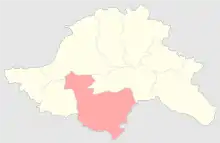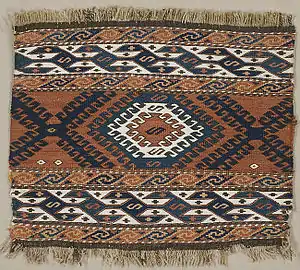Borchaly Uyezd
The Borchaly Uyezd (Russian: Борчалинский уезд) was a county of the Tiflis Governorate of the Caucasus Viceroyalty of the Russian Empire and then of Democratic Republic of Georgia and of Democratic Republic of Armenia with its administrative center in Shulaveri. Now, it is part of the Armenia's region of Lori and Georgia's region of Kvemo Kartli.
Borchaly Uyezd
Борчалинский уезд | |
|---|---|
.png.webp) Coat of arms | |
 | |
| Coordinates: 41°20′38″N 44°45′30″E | |
| Political status | Uyezd |
| Region | Caucasus |
| Established | 1880 |
| Abolished | 1918 |
| Area | |
| • Total | 6,758 km2 (2,609 sq mi) |
| Population (1897) | |
| • Total | 128,587 |
| • Density | 19/km2 (49/sq mi) |
History

The term "Borchaly" derives from Turcoman tribes that were resettled by Shah Abbas I (c.1571-1629) along Debed valley, after his successful campaigns against kingdoms of Kartli and Kakheti, that led formation several Qizilbash khanates on Georgian territory. Region was liberated by kingdom of Kartli in 18th century, the latter was incorporated to Kartli-Kakheti monarchy in 1762. In 1801, through Russia's annexation of eastern Georgia it became part of Russia's Tiflis Governorate. The border disputes between the newly independent Democratic Republic of Georgia and the First Republic of Armenia, over a part of Borchaly district led to a brief war between the two countries in December 1918.
Demography
According to census held in 1897, the population of uyezd was 128,587. The ethnic makeup of the district was the following:[1][2]
- Armenians - 47,423 (36.9%)
- Azerbaijanis[upper-alpha 1][1] - 37,742 (29.4%)
- Greeks - 21,393 (16.6%)
- Russians - 8,089 (6.3%)
- Georgians - 7,840 (6.1%)
- Germans - 2,496 (1.9%)
Notes
- "Further consolidation of different Turkic speaking ethnic groups (commonly known as Caucasian Tatars) led to the formation of the Azerbaijani community.[3]"
References
- "Archived copy". Archived from the original on 2012-08-29. Retrieved 2011-09-11.CS1 maint: archived copy as title (link) CS1 maint: bot: original URL status unknown (link)
- Борчалинский уезд (in Russian)
- The Ancient Orient. Transcaucasia in the 11th–15th centuries by Lev Gumilev